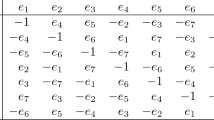Summary
New variables («new» as regards the space-time variables) are obtained starting from the requirement that their allowable values should leave the value of the Minkowski metric unchanged. To this purpose, the space-time variables are embedded into real and then complex nonassociative algebras (with an identity element) endowed with nondegenerate quadratic forms generalizing the Minkowski metric. The algebras are proved to fulfil the above-mentioned requirement if and only if they are composition algebras. Using the Hurwitz theorem, it is shown that in the real case there is only one allowable algebra, which is isomorphic to the eight-dimensional split real Cayley algebra, while, in the complex case, there are two allowable algebras: one is isomorphic to the four-dimensional complex quaternion algebra, the other is isomorphic to the eight-dimensional complex Cayley algebra. In the case of these three algebras, new variables and their allowable values are obtained. The essential role played in this context by the (multiplicative) noncommutativity and nonassociativity is pointed out in some final remarks.
Riassunto
Si ottengono nuove variabili («nuove» rispetto alle variabili dello spazio-tempo) partendo dalla richiesta che i loro valori permessi lascino invariato il valore della metrica di Minkowski. A tale scopo, le variabili dello spazio-tempo sono immerse in algebre non associative (con elemento identità) reali e poi complesse, munite di forme quadratiche non degeneri che generalizzano la metrica di Minkowski. Si dimostra che queste algebre soddisfano detta richiesta se e solo se sono algebre di composizione. Usando il teorema di Hurwitz, si fa vedere che, nel caso reale, esiste una sola algebra permessa, la quale è isomorfa all'algebra di Cayley reale split ottodimensionale, mentre, nel caso complesso, esistono due algebre permesse: una è isomorfa all'algebra quaternionica complessa quadridimensionale, l'altra è isomorfa all'algebra di Cayley complessa ottodimensionale. Nei casi di queste tre algebre, si ottengono nuove variabili e i loro valori permessi. Alcuni commenti finali mettono in risalto il ruolo essenziale esplicato, in questo contesto, dalla non commutatività e non associatività (moltiplicative).
Резюме
Получены новые переменные, исходя из требования, чтобы их допустимые значения не изменяли метрику Минковского. Для этой цели пространственно-временные переменные внедряются в вешественные и в комплексные неассоциативные алгебры, которые обладают невырожденными квадратичными формами, обошаюшими метрику Минковского. Доказывается, что эти алгебры удовлетворяют выщеуказанному требованию, если и только если они являются составными алгебрами. Используя теорему Хурвитца, показывается, что в вешественном случае сушествует только одна разрещенная алгебра, которая является изоморфной к восьмимерной расшепленной вещественной алгебре Кейлея, тогда как в комплексном случае сушествуют две разрещенные алгебре, а другая является изоморфной к восьмимерной комплексной алгебре Кейлея. В случаях этих трех алгебр, получаются новые переменные и их допустимые значения. Отмечается сушественная роль, которую играют некоммутативность и неассоциативность.
Similar content being viewed by others
References
S. Fubini andH. Nicolai:Phys. Lett. B,155, 369 (1985).
V. de Alfaro, S. Fubini andG. Furlan:Prog. Theor. Phys. Suppl., No. 86, 274 (1986).
K. Gödel:Rev. Mod. Phys.,21, 447 (1949).
A. Pais:Phys. Rev. Lett.,7, 291 (1961).
D. Finkelstein, J. M. Jauch, S. Schiminovich andD. Speiser:J. Math. Phys.,3, 207 (1962);4, 788 (1963).
J. Tiomono: inTheoretical Physics (1962 Trieste Seminar) (Vienna, 1963), p. 251.
P. Rastall:Rev. Mod. Phys.,36, 820 (1964).
A. Gamba: inHigh-Energy Physics and Elementary Particles (1965 Trieste Conference) (Vienna, 1965), p. 641;J. Math. Phys. (N. Y.),8, 775 (1967).
J. D. Edmonds:Int. J. Theor. Phys.,6, 205 (1972).
M. Günaydin andF. Gürsey:Lett. Nuovo Cimento,6, 401 (1973);J. Math. Phys. (N. Y.),14, 1651 (1973);Phys. Rev. D,9, 3387 (1974).
R. Casalbuoni, C. Domokos andS. Kövesi-Domokos:Nuovo Cimento A,31, 423 (1976).
M. Günaydin:J. Math. Phys. (N. Y.),17, 1875 (1976).
K. Morita:Lett. Nuovo Cimento,26, 50 (1979);Prog. Theor. Phys.,65, 787 (1981);65, 2071 (1981);67, 1860 (1982);68, 2159 (1982);70, 1648 (1983).
F. Gürsey, M. A. Jafarizadeh andH. C. Tze:Phys. Lett. B,88, 282 (1979);F. Gürsey andC. H. Tze:Phys. Lett. B,127, 191 (1983).
S. L. Adler:Phys. Rev. D,21, 2903 (1980).
E. R. Caianiello andA. Giovannini:Lett. Nuovo Cimento,34, 301 (1982).
R. T. Jantzen:J. Math. Phys. (N. Y.),23, 1741 (1982).
T. Kugo andP. Townsend:Nucl. Phys. B,221, 357 (1983).
T. Dereli, M. Panahimoghaddam, A. Sudbery andR. W. Tucker:Phys. Lett. B,126, 33 (1983).
J. W. Moffat:J. Math. Phys. (N. Y.),25, 347 (1984).
G. P. Wene:J. Math. Phys. (N. Y.),25, 414 (1984);25, 2351 (1984).
R. Dündarer, F. Gürsey andC. H. Tze:J. Math. Phys. (N. Y.),25, 1496 (1984).
L. P. Horwitz andL. C. Biedenharn:Ann. Phys. (N. Y.),157, 432 (1984).
N. Jacobson:Rend. Circ. Mat. Palermo, (2),7, 55 (1958).
R. D. Schafer:An Indroduction to Nonassociative Algebras (Academic Press, New York, N.Y., 1966), Chap. III.
K. A. Zhevlakov, A. M. Slin'ko, I. P. Shestakov andA. I. Shirshov:Rings that are Nearly Associative (Academic Press, New York, N. Y., 1982), Chap. 2.
N. Jacobson:Lie Algebras (Dover Publications, New York, N.Y., 1979), p. 142.
Author information
Authors and Affiliations
Additional information
Переведено редакцией.
Rights and permissions
About this article
Cite this article
Barucchi, G. Generalized Minkowski metric and composition algebras. Nuov Cim A 98, 41–59 (1987). https://doi.org/10.1007/BF02902352
Received:
Published:
Issue Date:
DOI: https://doi.org/10.1007/BF02902352



